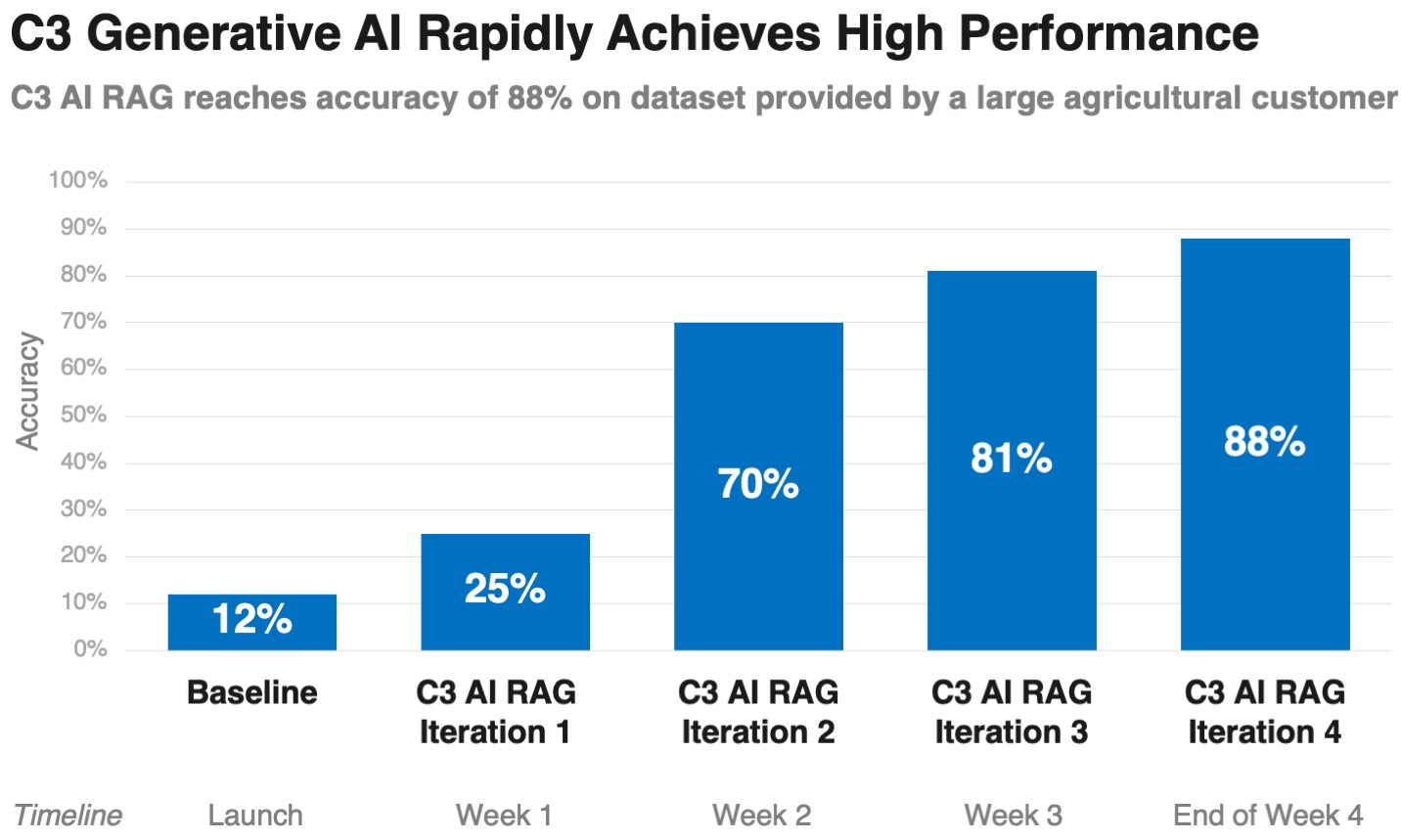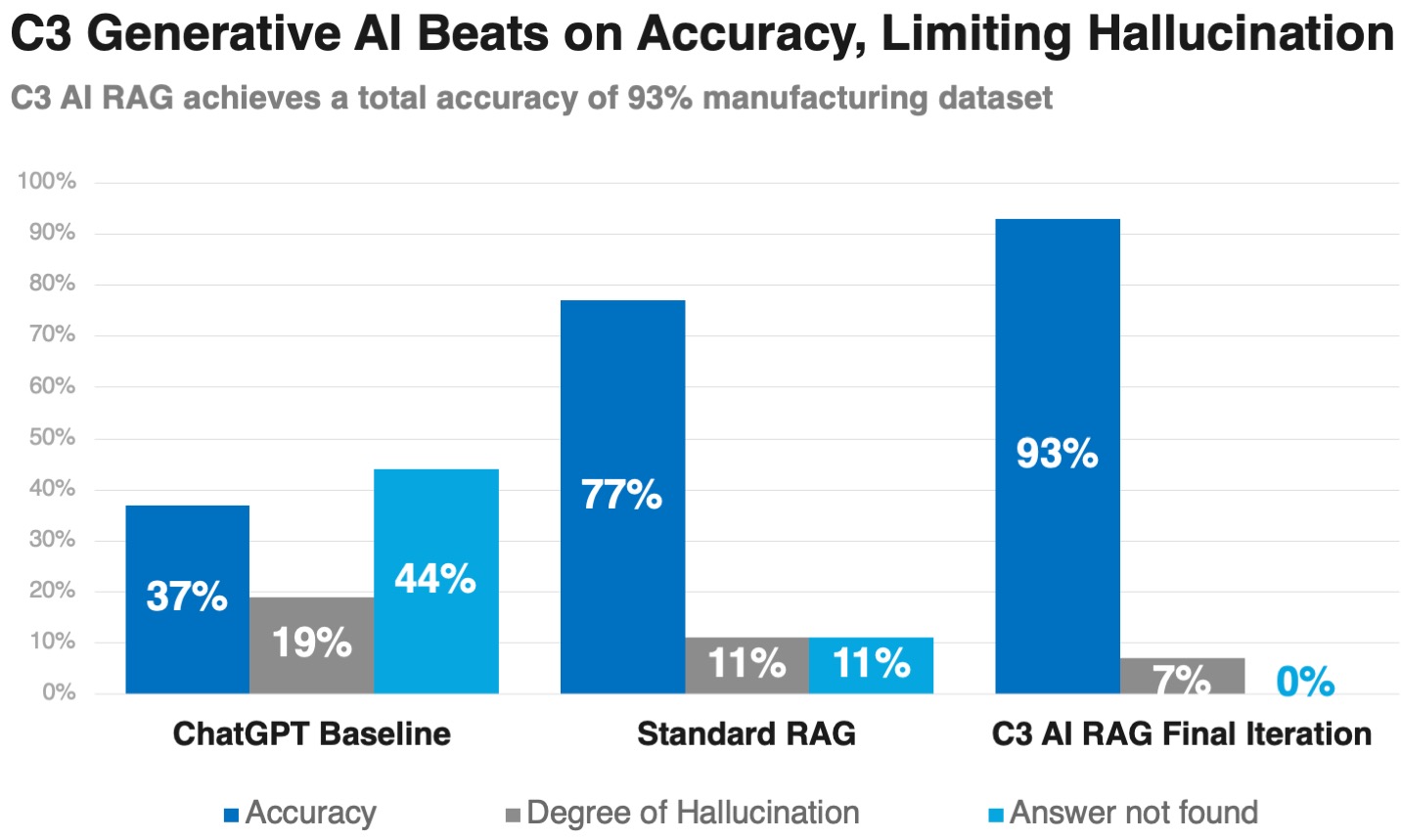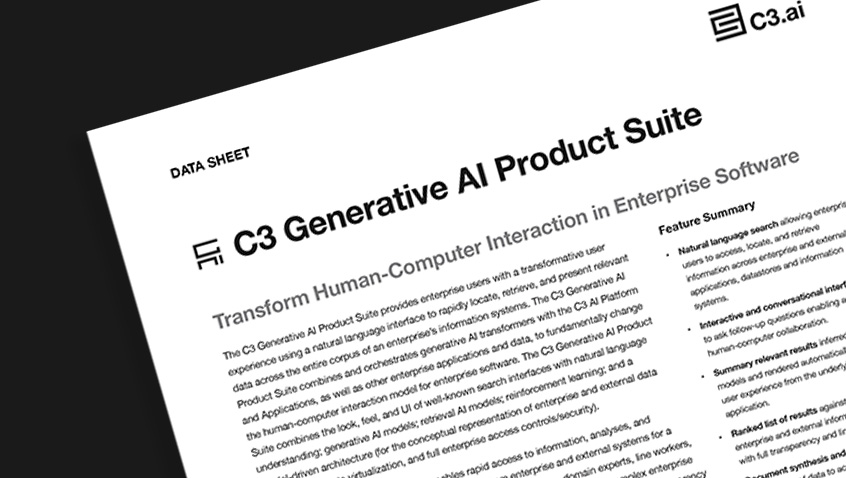- AI Software
- C3 AI Applications
- C3 AI Applications Overview
- C3 AI Anti-Money Laundering
- C3 AI Cash Management
- C3 AI Contested Logistics
- C3 AI CRM
- C3 AI Decision Advantage
- C3 AI Demand Forecasting
- C3 AI Energy Management
- C3 AI ESG
- C3 AI Health
- C3 AI Intelligence Analysis
- C3 AI Inventory Optimization
- C3 AI Process Optimization
- C3 AI Production Schedule Optimization
- C3 AI Property Appraisal
- C3 AI Readiness
- C3 AI Reliability
- C3 AI Smart Lending
- C3 AI Supply Network Risk
- C3 AI Turnaround Optimization
- C3 Generative AI Constituent Services
- C3 Law Enforcement
- C3 Agentic AI Platform
- C3 Generative AI
- Get Started with a C3 AI Pilot
- Industries
- Customers
- Events
- Resources
- Generative AI for Business
- Generative AI for Business
- C3 Generative AI: How Is It Unique?
- Reimagining the Enterprise with AI
- What To Consider When Using Generative AI
- Why Generative AI Is ‘Like the Internet Circa 1996’
- Can the Generative AI Hallucination Problem be Overcome?
- Transforming Healthcare Operations with Generative AI
- Data Avalanche to Strategic Advantage: Generative AI in Supply Chains
- Supply Chains for a Dangerous World: ‘Flexible, Resilient, Powered by AI’
- LLMs Pose Major Security Risks, Serving As ‘Attack Vectors’
- What Is Enterprise AI?
- Machine Learning
- Introduction
- What is Machine Learning?
- Tuning a Machine Learning Model
- Evaluating Model Performance
- Runtimes and Compute Requirements
- Selecting the Right AI/ML Problems
- Best Practices in Prototyping
- Best Practices in Ongoing Operations
- Building a Strong Team
- About the Author
- References
- Download eBook
- All Resources
- Publications
- Customer Viewpoints
- Blog
- Glossary
- Developer Portal
- Generative AI for Business
- News
- Company
- Contact Us
- Generative AI for Business
- Reimagining the Enterprise with AI
- What To Consider When Using Generative AI
- Why Generative AI Is ‘Like the Internet Circa 1996’
- Can the Generative AI Hallucination Problem be Overcome?
- Transforming Healthcare Operations with Generative AI
- Data Avalanche to Strategic Advantage: Generative AI in Supply Chains
- Supply Chains for a Dangerous World: ‘Flexible, Resilient, Powered by AI’
- LLMs Pose Major Security Risks, Serving As ‘Attack Vectors’
- C3 Generative AI: Getting the Most Out of Enterprise Data
- The Key to Generative AI Adoption: ‘Trusted, Reliable, Safe Answers’
- Generative AI in Healthcare: The Opportunity for Medical Device Manufacturers
- Generative AI in Healthcare: The End of Administrative Burdens for Workers
- Generative AI for the Department of Defense: The Power of Instant Insights
- C3 AI’s Generative AI Journey
- What Makes C3 Generative AI Unique
- How C3 Generative AI Is Transforming Businesses
C3 Generative AI: Getting the Most Out of Enterprise Data
Introducing a novel retrieval augmented generation approach for enterprises
By Graham Neubig, Associate Professor of Computer Science, Carnegie Mellon University

One question every enterprise asks nowadays is, “How can I use the power of generative AI to better access and use my data?” This can take many forms, but one of the most valuable is getting answers to important questions from the large amounts of unstructured data gathering dust in stores of PDFs, word documents, and rarely touched structured databases that most companies have in abundance.
In my work at Carnegie Mellon, I focus on fundamentals and applications of large language models (LLMs) to use cases such as question answering, software engineering, translation, and dialog. I have been working with C3 AI on its generative AI offerings, and I will share why, from a technical perspective, I find it to be a highly adept solution to a challenging yet important problem.
Why Extracting Insights from Enterprise Data Is So Hard
Using generative AI in enterprise-critical situations is no easy task, requiring a solution that overcomes a number of issues that emerge from when using machine learning and natural language processing. These include:
- Preventing hallucinations and citing sources. LLMs are known to fabricate answers when they don’t know something, which is a nonstarter in any commercial or government situation. They also don’t provide sourcing, making it impossible to trace answers back to the original data to ensure accuracy.
- Achieving complex reasoning and information aggregation. Answering a question such as, “Which data centers from our cloud provider are carbon-neutral?” may require first identifying all of the cloud provider’s data centers, retrieving datasheets from each, and checking whether they are listed as carbon neutral or not, and aggregating numerical information about each.
- Adapting to new domains. Most business applications require handling information from specialized domains that are not well-represented in academic training sets. It is necessary to be able to easily adapt to these new domains. Importantly, this adaptation can be done in a matter of weeks or even days, quickly ramping up usable systems.
- Difficulty in evaluation. It is sometimes hard to tell whether the outputs of an enterprise question-answering system are correct or sufficient, and which components of the system are leading to incorrect responses.
Even when these hurdles have been overcome, there are also logistical hurdles in deploying these systems in enterprise settings.
- Handling disparate data sources and a mix of structured and unstructured data. Enterprises data often resides in various data lakes and storage without a unified data access paradigm. Further, data can be in structured databases, and other data in unstructured forms such as PDFs, web pages, or word documents. It is typically necessary to parse and integrate all of these sources to get a comprehensive answer to important questions.
- Providing privacy and security guarantees. At the same time, not all data should be accessible to everyone, and it is necessary to respect access controls in place to ensure that data is viewed only by authorized users.
- Challenge productionizing. Even if a retrieval augmented generation (RAG) application can be created for a small number of documents and users, it is difficult to build the underlying technology stack to deploy a production-ready application. C3 Generative AI can be deployed for enterprise use within a week.
What is the C3 Generative AI Solution? A Novel RAG Approach.
The C3 Generative AI offering tackles these problems by accurately answering complex questions over large enterprise document collections, providing evidence for its reasoning, mitigating hallucinations, respecting privacy via access controls, and adapting easily to new settings. C3 Generative AI product is a sophisticated RAG framework that retrieves relevant information in response to the user query, and then uses an LLM to generate coherent results. C3 AI incorporates a number of novel improvements over other alternatives, all aimed at making the system robust and applicable to enterprise use cases.
High-precision, controllable information retrieval over multi-domain data sources. A first step to C3 AI’s technical approach is ensuring high-precision information retrieval over large collections of structured datasets (including relational tables, sensor data) and unstructured documents — a difficult task when handling a variety of data formats and domain-specific vocabulary. This is achieved through incorporating state-of-the-art methods for information retrieval that perform semantic matching of each part of the query to relevant parts of the retrieved documents. This is all backed up by robust information extractors that can parse and chunk passages from a variety of documents before indexing. This approach greatly reduces the number of hallucinations by ensuring that appropriate evidence is available to the model when it is generating results.
The underlying models can further be fine-tuned to specific enterprise use cases with the appropriate domain terminology. This is combined with the ability to rapidly engineer and automatically benchmark prompts designed for particular use cases.
Furthermore, many of C3 AI’s enterprise customers require strict access controls over the types of information that can be retrieved, a key component of the C3 AI Platform. For instance, retrieval can be restricted to adhere to access controls, ensuring no data is leaked to unauthorized viewers. There are also mechanisms to allow metadata filtering, which allows for retrieval of fresh information over stale information, or otherwise encourage the model to pay attention to particular varieties of documents or authors when answering questions.
Complex reasoning over heterogenous data. C3 AI’s technical approach makes it possible to answer complex questions where many other approaches fail. This is done by scaling up a new framework that C3 AI calls Read-Extract-Answer, inspired by the Demonstrate-Search-Predict paradigm.
C3 AI’s method works by gradually synthesizing information from multiple sources, retrieving new information as it becomes necessary to the model’s reasoning process. It’s particularly useful for complex questions enterprises need to ask from their datasets.
LLM-agnostic implementation. C3 AI’s method isn’t just a wrapper on top of a particular LLM, nor is it locked into a particular LLM ecosystem. This allows both the use of the latest open-source and commercial models, and implementation in air gapped environments that provide the strongest privacy and security guarantees. C3 AI pre-trains and fine-tunes open-source models to maximize accuracy on each step of the reasoning process, and tailor the LLM for specific use cases.
Automated evaluation framework. C3 AI rigorously benchmarks performance by using an automated evaluation framework based on three feedback loops. The innermost loop is fully automated and uses ML metrics to evaluate the model accuracy. The second loop uses ground truth to measure accuracy against expectations. The third and outermost loop involves the LLM grading itself;his evaluation loop requires prompt engineering and periodic calibration with human assistance.
This evaluation framework assesses each individual component of the RAG system, including the retrieval and generative components to identify errors.
Case Studies from C3 AI’s Enterprise Customers
In a business intelligence and analysis use case for a large agricultural firm, C3 Generative AI achieved almost 90% accuracy1 on a client-provided dataset that includes complex questions nested in dense tabular content in PDFs. Notably, this included a quick ramp up from a baseline approach that achieved approximately 12% accuracy, to a highly performant system using C3 AI library of adaptation strategies.

C3 AI also deployed its rapid adaptation framework to a manufacturing application to analyze scores of complex technical manuals. Within a week, C3 AI configured a RAG pipeline that achieved more than 90% accuracy2; when posing the same technical questions to OpenAI’s ChatGPT, it achieved a performance of just 37% accuracy.

C3 AI is innovating on the best methodology in generative AI to improve the ability of enterprises to better use their existing data. And this will serve as a solid platform for some of the things that are up next, including:
- Industry-specific and domain-specific models tailored to an enterprise’s use cases.
- Blueprints that encode expert knowledge into a workflow of queries.
- Code generation for C3 AI’s domain-specific language, integrating seamlessly with other C3 AI applications.
- Agents and tools that can handle more complex tasks (e.g., mathematical, logical reasoning, viewpoint comparison)
With strong expertise building enterprise-ready generative AI solutions and a broad array of domain-specific adaptation techniques, C3 AI has the ability to quickly build powerful RAG-based applications for a variety of enterprise use cases.
1 Accuracy: Human evaluation of the number of correct answers generated by C3 AI’s RAG solution that align with expected answers divided by the total of 45 questions.
2 Accuracy: Human evaluation of the number of correct answers generated by C3 AI’s RAG solution that align with expected answers divided by the total of 70 questions.
C3 Generative AI



